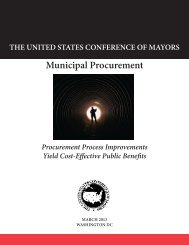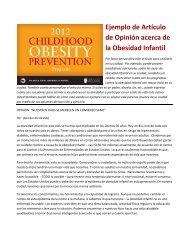Writing Proposals for HIV/AIDS Prevention Grants - U.S. Conference ...
Writing Proposals for HIV/AIDS Prevention Grants - U.S. Conference ...
Writing Proposals for HIV/AIDS Prevention Grants - U.S. Conference ...
Create successful ePaper yourself
Turn your PDF publications into a flip-book with our unique Google optimized e-Paper software.
6 TECHNICAL ASSISTANCE REPORTS March 2003Using Statistics toDemonstrate <strong>HIV</strong> Risk• Make sure that any statistics you cite are up-todateand accurate; the persuasiveness of yourargument will be weakened if you don’t botherto check your facts or use outdated statistics.• Whenever possible, use local–rather than stateor national–data to illustrate your point, even ifthey are limited or anecdotal (based on yourexperience). Using local data will assure reviewersthat your organization knows what’s goingon with the target population in the targetcommunity.• Don’t include in<strong>for</strong>mation that doesn’t directlyrelate to the point you’re trying to make just tofill up space; it will only take away from youroverall argument.• Avoid repeating a long list of statistics that youhave copied from elsewhere without interpretingthem; help the reader understand what thesestatistics mean and how they relate to the reallifeproblems of people in your community.• Always provide references and dates of publication<strong>for</strong> the data that you cite so that reviewers canknow what the source of that data is and howcurrent the data are.Demonstrating <strong>HIV</strong>Risk When Limited DataExist on Your TargetPopulationNot all populations have a current or likely <strong>HIV</strong>problem. Even populations with serious social and economicproblems may not be at great risk <strong>for</strong> <strong>HIV</strong>. Youmust make an honest assessment of whether or not an<strong>HIV</strong> prevention intervention is needed <strong>for</strong> a particularpopulation be<strong>for</strong>e you can make a persuasive case tofunders. Still, there may be times when you believe aspecific population is at risk <strong>for</strong> <strong>HIV</strong>, even though thisrisk may not be fully reflected, or reflected at all, in official<strong>HIV</strong>/<strong>AIDS</strong> surveillance data. For example:• Persistent under-reporting and misclassification have madeit impossible to know the true extent of <strong>HIV</strong>/<strong>AIDS</strong>among Native Americans and Asians/Pacific Islanders.• The <strong>HIV</strong>/<strong>AIDS</strong> status of homeless persons or migrantworkers is very hard to determine because of the mobileand sometimes “hidden” nature of these populations.• Frequently <strong>HIV</strong>/<strong>AIDS</strong> cases among male-to-femaletransgendered people are not reported separately butare included with MSM cases, even though their riskfactors are specialized and transgenders may be atmuch higher risk than MSM in general.• Women who seem to be low-risk may be at riskbecause of unacknowledged risk behaviors amongtheir male partners such as injection drug use orsame-sex contact.In instances like these, there are various strategiesyou can use to demonstrate convincingly that there is areal problem in your target population.a) Use surrogate data. If primary surveillance data(reported cases of <strong>HIV</strong> and <strong>AIDS</strong>) on your targetpopulation is lacking, look <strong>for</strong> other official data thatcan demonstrate a potential risk <strong>for</strong> <strong>HIV</strong>. For example,some Native Americans may not appear to belong toThe United States <strong>Conference</strong> of Mayors • 1620 Eye Street,NW • Washington, DC 20006 • (202) 293-7330www.usmayors.org/uscm











